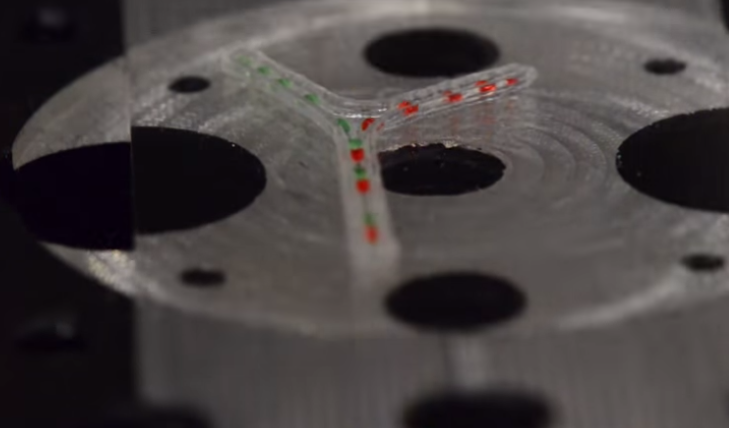The world is privy on a daily–and often hourly–basis to a host of incredible new innovations being presented by brilliant 3D printing innovators, from the flashiest of items like 3D printed rocket parts to gruesome 3D printed special effects in the film industry. It’s also becoming more common to see 3D printing in areas like jewelry and apparel and really, almost everywhere.
What many don’t realize is that 3D printing can also be used to make items you may not ever see, but that are far more important. Not always in the forefront and not always center stage, often the technology of 3D printing is used behind the scenes as well and even internally, resulting in substantial medical breakthroughs, as well as improving the quality of life for many. We are watching these innovations progress as well, most especially with a recent 3D printed guide which actually works to help nerves grow back after trauma.
Researchers from the University of Minnesota, Virginia Tech, University of Maryland, Princeton University, and Johns Hopkins University have just recently published a study with their findings, in Advanced Functional Materials, highlighting a 3D printed guide fabricated with silicone. Aside from Michael McAlpine, the study’s lead researcher, contributors were Blake N. Johnson, Virginia Tech; Xiaofeng Jia, University of Maryland and Johns Hopkins University; and Karen Z. Lancaster, Esteban Engel, and Lynn W. Enquist, Princeton University.
Funded by the National Institutes of Health, the Defense Advanced Research Projects Agency, the Maryland Stem Cell Research Fund, and the Grand Challenges Program at Princeton University, researchers have produced something we’ve never seen before, with a 3D printed device that actually helps regenerate both the sense of feeling and the ability to move.
Not only is regrowing nerves an extremely ambitious project in terms of 3D printed innovation, it’s rarely successful in any case, with patients often being resigned to permanent loss. Researchers tested the 3D printed guides on lab rats and found success, however.
“This approach suggests the potential of 3D printing toward advancing tissue regeneration in terms of: (1) the customization of scaffold geometries to match inherent tissue anatomies; (2) the integration of biomanufacturing approaches with computational modeling for design, analysis, and optimization; and (3) the enhancement of device properties with spatially controlled physical and biochemical functionalities, all enabled by the same 3D printing process,” stated the researchers in their paper, ‘3D Printed Anatomical Nerve Regeneration Pathways.’
From the lab, the project consisted of ‘reverse engineering’ the rat’s sciatic nerve and then creating the guide meant to fix it by grafting it onto the ends of the nerve which were cut. With a watch and wait kind of study lasting ten to twelve weeks, at the end the rat was able to walk in an improved manner.
“This represents an important proof of concept of the 3D printing of custom nerve guides for the regeneration of complex nerve injuries,” said University of Minnesota mechanical engineering professor Michael McAlpine, the study’s lead researcher. “Someday we hope that we could have a 3D scanner and printer right at the hospital to create custom nerve guides right on site to restore nerve function.”
McAlpine’s vision shows how much patients will be able to benefit in the future from the current work and research being performed at hand. While the 3D printing portion of the project may be quick, waiting to see what happens takes more patience for all involved as regeneration does take weeks.
“The exciting next step would be to implant these guides in humans rather than rats,” McAlpine said, foreseeing in the future the concept of a ‘library’ that medical professionals can use for finding previously scanned nerves and then 3D print them.
While it is a complex procedure to pull off in any case, McAlpine reported that previously scientists have been able to see regrowth in nerves that were more simple due to being linear, they are now for the first time seeing regrowth with something like the more complex sciatic nerve–shaped like a ‘y’ and encompassing sensory and motor ‘branches,’ which offer more challenge to fix. This represents great hope, with surely much more progress and innovation to be made, in the area of traumatic injury. To see more on the full article, click here.
What do you think about their 3D printed nerve guides? Let us know in our forum.
Subscribe to Our Email Newsletter
Stay up-to-date on all the latest news from the 3D printing industry and receive information and offers from third party vendors.
You May Also Like
3D Printing Unpeeled: New Arkema Material for HP, Saddle and Macro MEMS
A new Arkema material for MJF is said to reduce costs per part by up to 25% and have an 85% reusability ratio. HP 3D HR PA 12 S has been...
3D Printing News Briefs, January 20, 2024: FDM, LPBF, Underwater 3D Printer, Racing, & More
We’re starting off with a process certification in today’s 3D Printing News Briefs, and then moving on to research about solute trapping, laser powder bed fusion, and then moving on...
3D Printing Webinar and Event Roundup: December 3, 2023
We’ve got plenty of events and webinars coming up for you this week! Quickparts is having a Manufacturing Roadshow, America Makes is holding a Member Town Hall, Stratafest makes two...
Formnext 2023 Day Three: Slam Dunk
I’m high—high on trade show. I’ve met numerous new faces and reconnected with old friends, creating an absolutely wonderful atmosphere. The excitement is palpable over several emerging developments. The high...

































